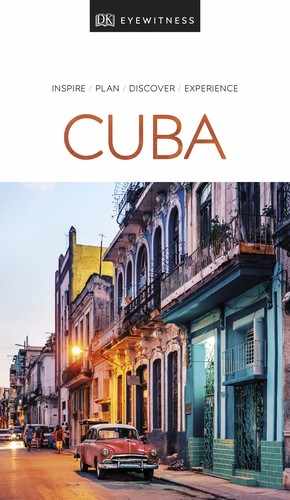experience
After the revolution, Fidel Castro denounced golf as “bourgeois” and in 1961, after playing a round with Che Guevara at the former Havana Country Club, the grounds were converted into a campus for the Instituto Superior de Arte. Cuban architect Ricardo Porro and Italian architects Vittorio Garatti and Roberto Gottardi were hired to design faculties of music, ballet, modern dance, and visual and plastic art. But the domed, sinuous red-bricked complex was never completed – both the concept of a school for the arts and the design itself fell out of favour in 1965 and were abandoned.
Advance permission is needed to enter, but there are good views of the complex from calles 15 and 134.
During the US occupation of Cuba (1898–1902), the military government chose Camp Columbia, in the Marianao district inland of Miramar, as its headquarters. Here, Fulgencio Batista enacted his 1933 and 1952 coups d’état, and fled Cuba on 31 December 1958; the camp was famously bombed on the eve of the Bay of Pigs invasion.
Castro turned the site into Ciudad Escolar Libertad, an educational centre and headquarters of the national literacy campaign. The on-site Museo de la Campaña de Alfabetización tells the story.
Plaza Finlay, outside the entrance, is pinned by a monument (El Obelisko) resembling a syringe to honour Dr Carlos Finlay, who identified the species of mosquito that causes yellow fever. The curved Art Deco buildings are carved with impressive bas-reliefs.

Insider Tip
Tropicana Tickets
For many people, Tropicana – Miramar’s infamous cabaret – is synonymous with Cuba. The best ticket deals can be found on Tropicana’s website (www.cabaret-tropicana.com).
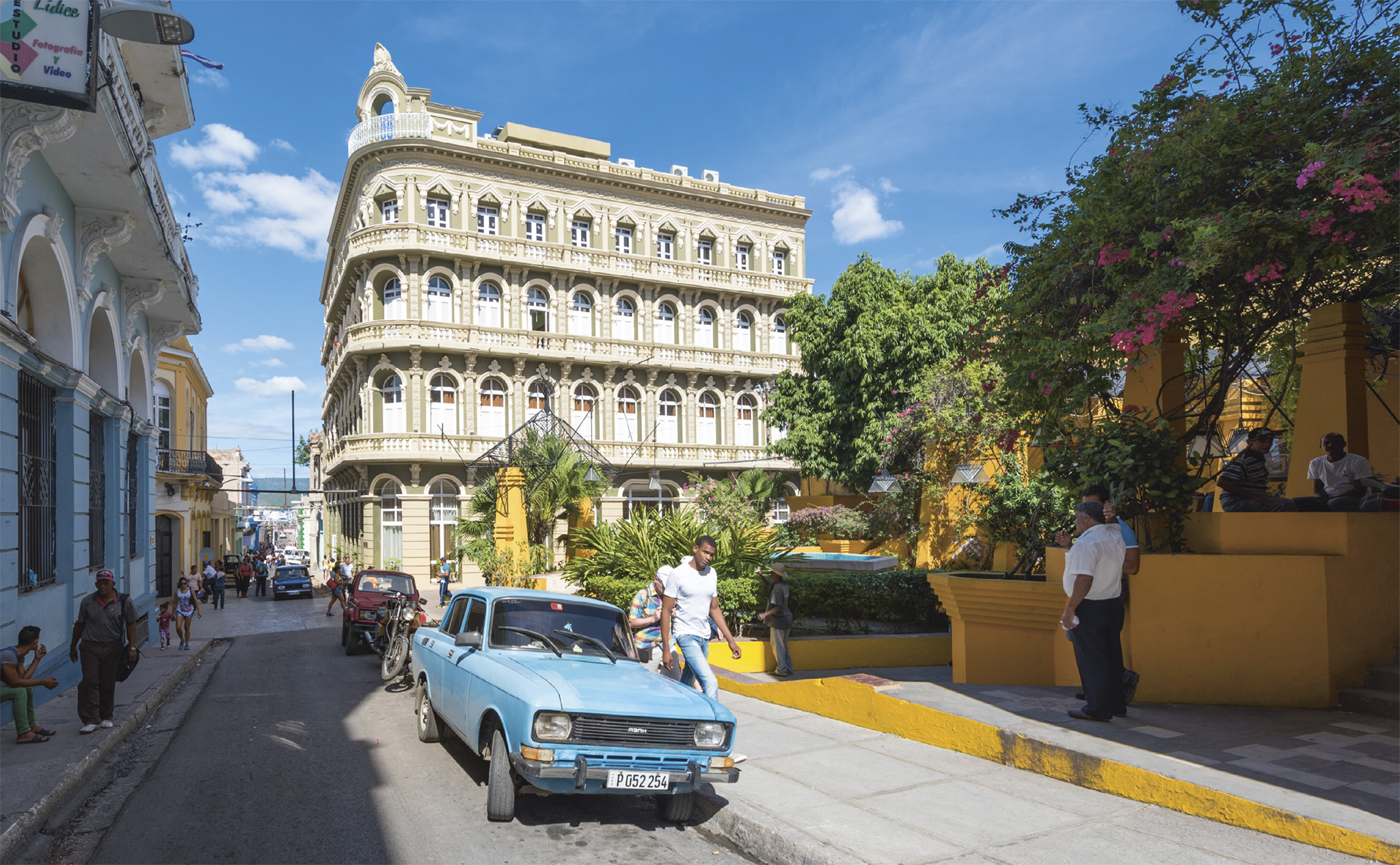
t Cars parked in front of a hotel on a street in the neighbourhood of Cubanacán
Rising inland to the west of Miramar, Cubanacán is the city’s most exclusive residential area. Colloquially called “Havana’s Beverly Hills”, it was developed from the 1920s onwards with winding tree-lined boulevards graced by flamboyant mansions and stunning Modernist homes. Most of the residents fled Cuba after the revolution and the area is now home to foreign ambassadors and members of Cuba’s governmental and military elite, while other buildings serve as protocolos (homes rented only to VIP guests).
The extravagant 1910 Beaux Arts mansion of the Marqués de Pinar del Río is the unlikely venue for the Fábrica El Laguito, the principal factory making Cohiba cigars. Nearby, the austere Palacio de las Convenciones, built in 1979, is Cuba’s main conference venue and host to the biannual sitting of the Asamblea Nacional del Poder Popular.
Did You Know?
Artist José Fuster’s nickname is “the Picasso of the Caribbean”.

t The enticing, colourful entrance to Fusterlandia, adorned with mosaics
Once a fishing and military community on the western edge of Havana called Jaimanitas, Fusterlandia gained its new name as a result of the mosaic work of Cuban artist José Fuster. By ornamenting his home town, Fuster launched this remarkable artistic community project. Fusterlandia is now covered with flamboyant and naïve ceramic artwork. You’ll see it on walls, pavements and dozens of homes. Although inspired by Gaudi, Picasso and Romanian artist Constantin Brâncuşi, Fuster’s themes are purely Cuban: palm trees, crocodiles, cockerel, couples making love. Don’t miss the Casa-Estudio Fuster (the artist’s surreal home and studio) which has the most astounding adornment.
Fidel Castro’s home was nearby, connected by tunnel to the Jaimanitas naval facility at Punta Cero. Avenida 5ta between calles 188 and 250 is still a no-photography zone.
World-renowned artist Kcho (Alexis Leiva Machado), recipient in 1995 of the UNESCO Prize for Promotion of the Arts, created this cultural complex in 2014. It includes a working foundry, pottery, carpentry workshop, library experimental graphics workshop, theatre, computer room, and various art galleries. There are guided tours by appointment, and visitors can join the free community arts classes.
Spilling onto neighbouring streets, the Museo Orgánico Romerillo community project studs pavements and grassy boulevard medians with installations, adding colour and vitality to the sub-district of Cubanacán. The project has engaged local residents, who cleaned up rubbish dumps and helped them become pleasant parks.
Experience Beyond the Centre
|
shop Casa-Estudio Fuster Fuster’s naïve ceramics and paintings can be bought at the artist’s studio. Big canvases fetch thousands of dollars, but small items start at $35. ⌂ Avenida 1ra y 226 (Havana) § 7271 2932 |
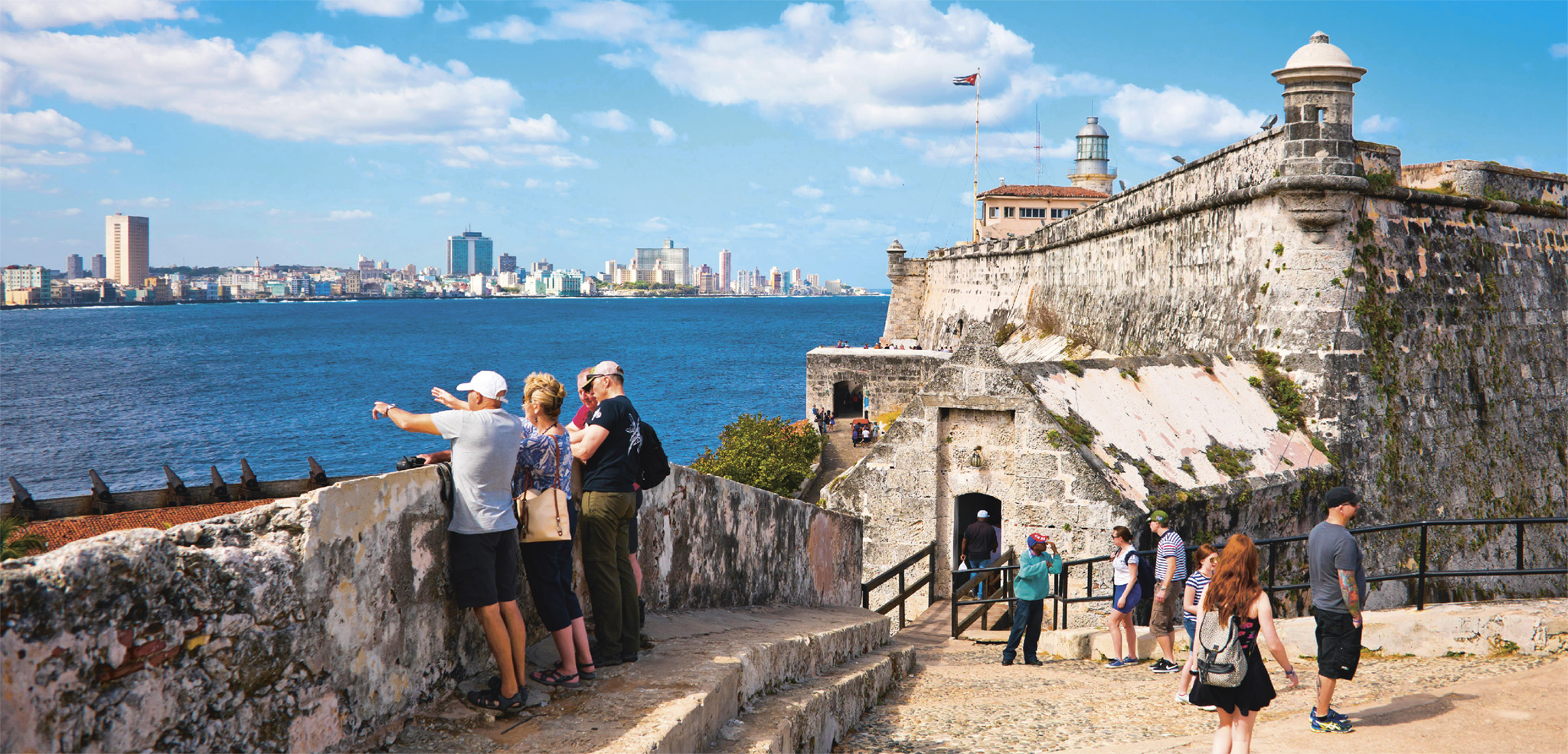
t Looking towards La Habana Vieja from the historic Castillo del Morro
Construction of this fortress, which was designed by the Italian military architect Giovanni Bautista Antonelli, began in 1589 at the request of the governor Juan de Texeda. The function of the Castillo de los Tres Reyes del Morro (its full title) was to detect the approach of any enemy. Various treasures of the New World were regularly concentrated in the port when ships were docked in Cuba on their voyage to Spain, and it was necessary to protect them.
The original lighthouse on the “Morrillo”, the highest point of the hill, was rebuilt several times, until General Leopoldo O’Donnell ordered a new one to be built in 1845. This still stands today. It is made of stone, and has its original lamp, with rays that shine for a radius of 30 km (20 miles). Today the fortress and the neighbouring San Carlos de La Cabaña fortification form the Parque Histórico-Militar Morro Cabaña. Many tourists and locals come to admire the magnificent view of the city and port of Havana.
Access to the castles is through an impressive gallery, where plaques indicate the spot where the British opened a breach in 1762, taking the Morro and all of Havana after a 40-day siege.
On the northern side, the Plataforma de la Reina has defence walls and steps leading to the upper terrace. From here visitors can gain an overall view of the fortress.
Experience Beyond the Centre
The Cañonazo

Every evening, at 9pm exactly, the “Cañonazo” ceremony is held in La Cabaña fortress. On the hour, a volley of cannon shots is fired by a group of young soldiers of the Revolutionary Armed Forces, dressed in 18th-century uniforms. This theatrical ceremony recalls the colonial period, when shots were fired at the end of each day to tell citizens that the city gates were closed and access to the bay had been blocked.
After the British conquest of Havana in 1762, it was 11 months before the Spaniards regained the capital. The bitter experience of foreign occupation convinced them of the need to fortify the hill dominating the port, so, in 1763, construction began on the new Cabaña fortress. No fewer than 4,000 men laboured on the project, including Mexican and Indian prisoners brought from the Yucatán peninsula in conditions of semi-slavery.
The new fortification cost 14 million pesos, a sum so large that, according to an old legend, King Carlos III of Spain on hearing of the expense asked for a spyglass and reputedly said: “Such an expensive construction should be visible from Madrid.”
La Cabaña, which extends for more than 700 m (2,300 ft) along the entrance canal of the bay, is a huge 10-ha (25-acre) polygon designed in keeping with the principles of French military schools, but with detailing by the Spanish engineer Silvestre Abarca. With its crown- shaped plan, the structure is considered a fine example of a bastion-type fortification.
A visit to the fortress is a journey through history. The central thoroughfare leads to the Baluardo di San Ambrosio bastion and the Terraza de San Agustín, where the poet Juan Clemente Zenea was executed for his separatist ideas in 1871. In the same area are some Soviet nuclear missiles, left over from the 1962 Cuban Missile Crisis.
The Museo Monográfico illustrates the history of the fortress through documents and photographs. The Museo de Armas y Fortificaciones is a military museum. The one museum not to miss is the Comandancia del Che: on 3 January 1959 the barbudos (as Castro and his bearded revolutionaries were known) occupied La Cabaña and set up their headquarters in what was once the Spanish military governor’s residence. Today it is a museum containing various items that belonged to Che Guevara, including his weapons, glasses and camera. The revolutionary’s original office, which has been left intact, is also open to visitors.
Did You Know?
A chain between Castillo del Morro and Castillo San Salvador de la Punta used to block the harbour.
Experience Beyond the Centre
|
drink Casa de la Música One of Havana’s hottest salsa venues, Casa de la Música hosts top bands. Upstairs, Disco Tun Tún has dancing till dawn. ⌂ Calle 20 Avenida 35 (Havana) § 7204 0447 ¢ Mon & Tue Espacios This private club is popular with the party crowd. It has an outdoor space for live music, as well as indoor lounges. ⌂ Calle 10 513 e/ Avenida 29 y 31 (Havana) § 7202 2921 |
This fishing village was built in the 1700s on the other side of the Bay of Havana from the city. It is best known for the huge Cristo de La Habana, an 18-m- (60-ft-) tall white marble statue of Christ, which looms over the village. The work of the Cuban sculptor Jilma Madera in 1958, it was commissioned by President Batista’s wife, Marta, who had made a vow to finance a large statue of Christ if her husband survived the 1957 attack by students on the presidential palace. Ironically, the statue was completed a week before the revolution. It can be seen from many parts of the city and is familiar to all Cubans.

t The gleaming white Cristo de La Habana statue in Casablanca

t Statues in alcoves lining the walls of Nuestra Señora de la Virgen de Regla church
Regla lies on the east coast of the Bay of Havana, a few minutes by ferry from Muelle de Luz. The town was founded in 1687 and over the years grew in economic importance as a fishing port and centre for huge sugar warehouses. In the 19th century freed slaves settled in Regla, and there is still a strong Afro-Cuban culture here today.
The church of Nuestra Señora de la Virgen de Regla was built here in 1687. A modest structure, it stands on a small hill from which there are scenic views of the bay of Havana. The humble interior includes an ornate golden altar incorporating the figure of the dark-skinned Virgin, dressed in ornate blue robes.
The Liceo Artístico y Literario – the town’s centre for art and literature – was opened by José Martí in 1879 with a famous speech on Cuban independence.

t Nuestra Señora de la Virgen de Regla church
After its foundation in 1607, this town became a port of call for slave traffic, which explains its fame as a city associated with Afro-Cuban culture. Its name, of Indian origin, means “land of many waters”: there are several springs in this area which at one time encouraged wealthy Habaneros to build homes here. Today, the town is proud of its colonial houses and of having been the birthplace of three leading 20th-century Cuban musicians: pianist and composer Ernesto Lecuona, singer Rita Montaner and chansonnier Ignacio Villa, better known as Bola de Nieve.
Guanabacoa has several interesting churches. Of these, the Ermita de Potosí in particular is well worth a visit. Built in 1644, it is one of the oldest and most original colonial-period churches.
The interesting Museo Municipal de Guanabacoa, in a well-restored colonial house, illustrates the history of the town. The dominant figure is that of Pepe Antonio, the local hero in the struggle against the British in the 18th century. The museum places particular emphasis on the Santería and Palo Monte religions and on the rituals of the Abakuá cult. An impressive piece in this section is the Mano Poderosa, a multicoloured wooden sculpture that stands approximately 1 m (3 ft) high. According to legend, it once belonged to a woman who was able to make contact with the dead. Traditional Afro-Cuban dance is sometimes held in the courtyard.
Museo Municipal de Guanabacoa
" ' ⌂ Calle Martí 108, e/ Quintin Banderas y E V Valenzuela § 7797 9117 # 9am–5pm Mon–Sat, 9am– 1pm Sun

Picture Perfect
A Water Landscape
As well as being a convenient way to get to Regla, the ferry from Muelle de Luz grants breathtaking views of Havana from the water. Cross at sunset and point your lens at the capital’s Instagram-ready skyline.
A charming village with single-storey wooden houses Cojímar was once inhabited only by fishermen. Now there are also escapees from the capital, including writers and artists, who have chosen to leave for a more peaceful life.
In the 1950s however, there was only one author to be seen on the streets of Cojímar: Ernest Hemingway. Many of the local fishermen were Hemingway’s friends and he liked to play dominoes and drink rum while listening to their stories. He made this village the setting for his famous novel The Old Man and the Sea.
In the small square named after Hemingway there is a monument featuring a bust of the author – a faithful copy of the one in El Floridita. It is here thanks to the author’s fishermen friends, who donated anchors, hooks and tools to pay for the casting.
Nearby, on the seafront, is a small fort, which was built as the easternmost defence point of Havana in 1646. It was designed by Giovanni Bautista Antonelli, architect of the Castillo del Morro.
Cojímar is also the home of Hemingway’s favourite restaurant, La Terraza (Calle Real 161). It makes much of its connection with the author, and photos of him adorn the walls. The restaurant is as elegant and well run as it was during Hemingway’s time. The cocktail lounge has a splendid wooden bar and is an ideal spot to enjoy a drink.
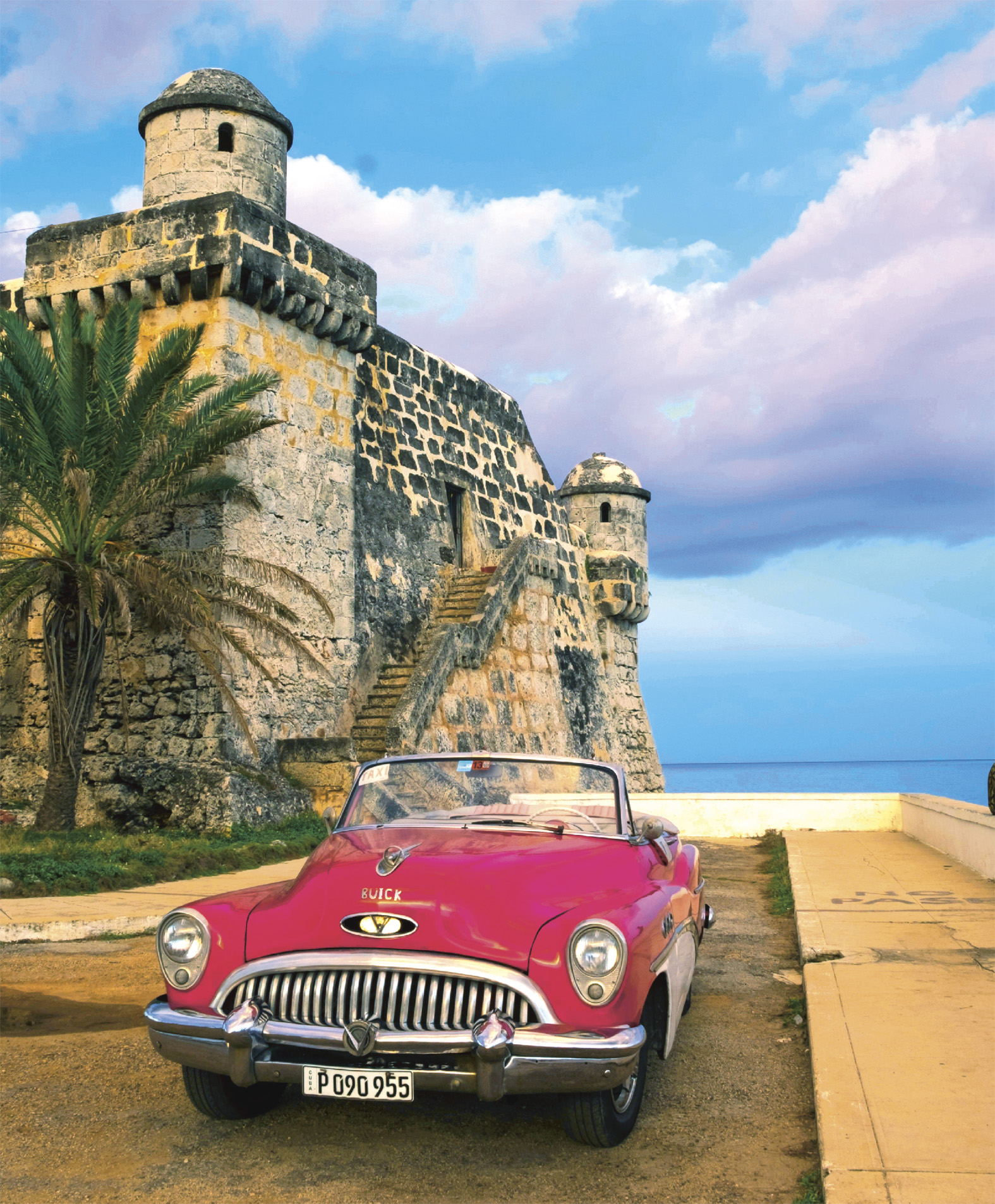
t A classic car parked by the water in front of Cojímar’s 17th-century fort
Experience Beyond the Centre
|
stay Cañaveral House This three-bedroom casa particular has both antique and contemporary touches. The garden has a plunge pool. ⌂ Calle 39A 4402 (Havana) ∑ cubaguesthouse.com \ Hotel Meliá Habana Located on the seafront, upscale Hotel Meliá Habana has five restaurants, a swimming pool and a gym. ⌂ Avenida 3ra e/ 76 y 80 (Havana) ∑ meliacuba.com \ |

t Sailing boats and kayaks on the sands of Playas del Este
Havana is one of the few cities in the world to have sizable beaches only a 20-minute drive from the city centre. Easy to reach via a good, fast road, the Playas del Este consist of a stretch of about 10 km (6 miles) of fine sand and crystal-clear water, lined with hotels, villages and tourist facilities. The beaches can offer a good compromise for people who want to spend some of their holiday at the seaside during their visit to Havana. Bear in mind, however, that this area is also a popular haunt of jineteros (touts promoting hotels and restaurants), though in places security guards have been drafted in to deter them.
Arriving from central Havana, the first beach you’ll reach is Bacuranao, a peaceful spot and a favourite with families. The loveliest place on the riviera is Santa María del Mar. It has the best beach, lined with pine and coconut trees, as well as some hotels and sport facilities, and is therefore very popular with tourists. Guanabo is a more traditional spot, with small houses, local restaurants and shops; at weekends this is the liveliest place along the coast when Habaneros arrive by the hundred. The Bajo de las Lavanderas, close to the shore, is a delight for scuba and skin divers, and deep-sea fishing trips can be arranged at the Marlin Náutica kiosks on the beaches.
A small island, Mi Cayito, lies at the mouth of the Itabo river. It has a lively beach which is popular with the local LGBT community.
Did You Know?
Alamar is a centre for rap and hip-hop and hosts Cuba’s annual Festival de Rap Cubano in August.
A vast post-revolutionary urban complex 5 km (3 miles) east of the Havana harbour tunnel, Alamar at first sight looks ghastly, with hundreds of identical Soviet-style pre-fabricated blocks of flats arranged without logical order. Most of the builders were unskilled volunteers who formed “micro-brigades” to construct units they would then occupy. Some 100,000 people live here.
First impressions aside, Alamar is not without off-beat charm. Don’t miss Oranipónico Alamar, an organic farm to the west of the town, which is run as a private cooperative on land leased rent-free from the state. It’s fascinating, and has tours in English. Nearby is one of Havana’s most colourful markets.
Finding any Alamar address is like navigating the minotaur’s maze, but ask a local to direct you to Jardín de los Afectos (Calle 7ma and 171, Zona 10), which has funky art made from recycled miscellany by artist Gallo Portieles.
Oranipónico Alamar
" '
⌂ Avenida 5ta

Great View
Sundown Style
Enjoy a sundown with a sundowner at the Mirador de Bello Monte, a hilltop bar off the Vía Blanca highway. This well-known spot has panoramic views over the white sands and iridescent sea of the entire length of the Playas del Este.

t The living room, lined with Hemingway's African hunting trophies, at Finca La Vigía
Finca La Vigía is the only home Ernest Hemingway ever had outside the US, and he lived here, between various foreign trips, for almost 20 years.
The villa, built in 1887 to a design by Catalan architect Miguel Pascual y Baguer, was bought by Hemingway in 1940. It was made a public museum in 1962, as soon as news of the writer’s suicide in the US reached Cuba. To protect the interior, visitors are not allowed inside, but the rooms can be viewed through the windows and doors to the garden, which are thrown open but roped off, except on rainy days.
Everything in Finca La Vigía is in the same meticulous order it was in when Hemingway lived here. There is his library with more than 9,000 books; various hunting trophies from African safaris hanging in the living room; personal possessions, such as his weapons and typewriter; and valuable artworks, including a ceramic plate by Picasso.
Two curious features in the garden are the pet cemetery (Hemingway had about 50 cats during his lifetime) and the Pilar, the author’s fishing boat, which was transferred from Cojímar to the museum and placed in a specially built pavilion in the former tennis court. The Pilar was a comfortable and fast boat made of black American oak, and the author loved ploughing through the waves on fishing expeditions with his friend Gregorio Fuentes. The boat became infamous as, during World War II, Hemingway used it to patrol the sea north of Cuba, on the lookout for Nazi submarines that were trying to sink ships laden with sugar intended for the Allied troops.
Experience Beyond the Centre
Hemingway in Cuba
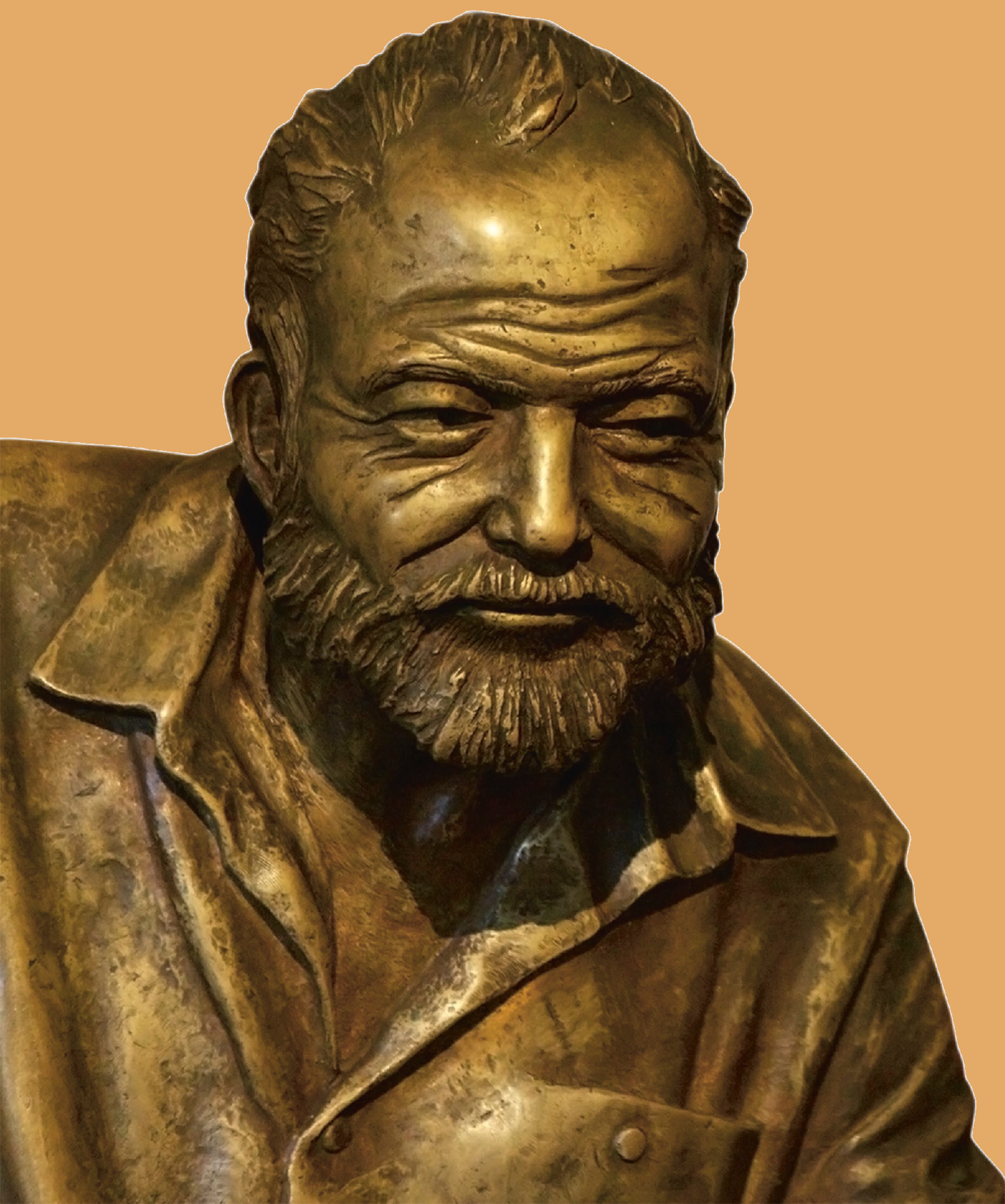
The great American author fell in love with Cuba on his first visit in 1932, attracted initially by the marlin fishing. It was not until 1939, however, that he decided to move to the island, initially residing in the Ambos Mundos hotel in La Habana Vieja before purchasing Finca La Vigía, a quiet villa outside the city. He wrote a number of his most famous novels there, and considered himself a Cuban. He returned to the US in 1960 after the Cuban revolution of 1959.
Near Hemingway’s villa is the village of Santa María del Rosario, founded in 1732 and home to the church of the same name (also known as Catedral de los Campos de Cuba), notable for its splendid mudéjar ceilings.
The church, designed in 1760–66 by José Perera, has an austere façade similar to Spanish missions in the western US, while the interior has some unusually lavish elements, such as the gilded high altar, and paintings by Nicolás de la Escalera, one of Cuba’s early artists.
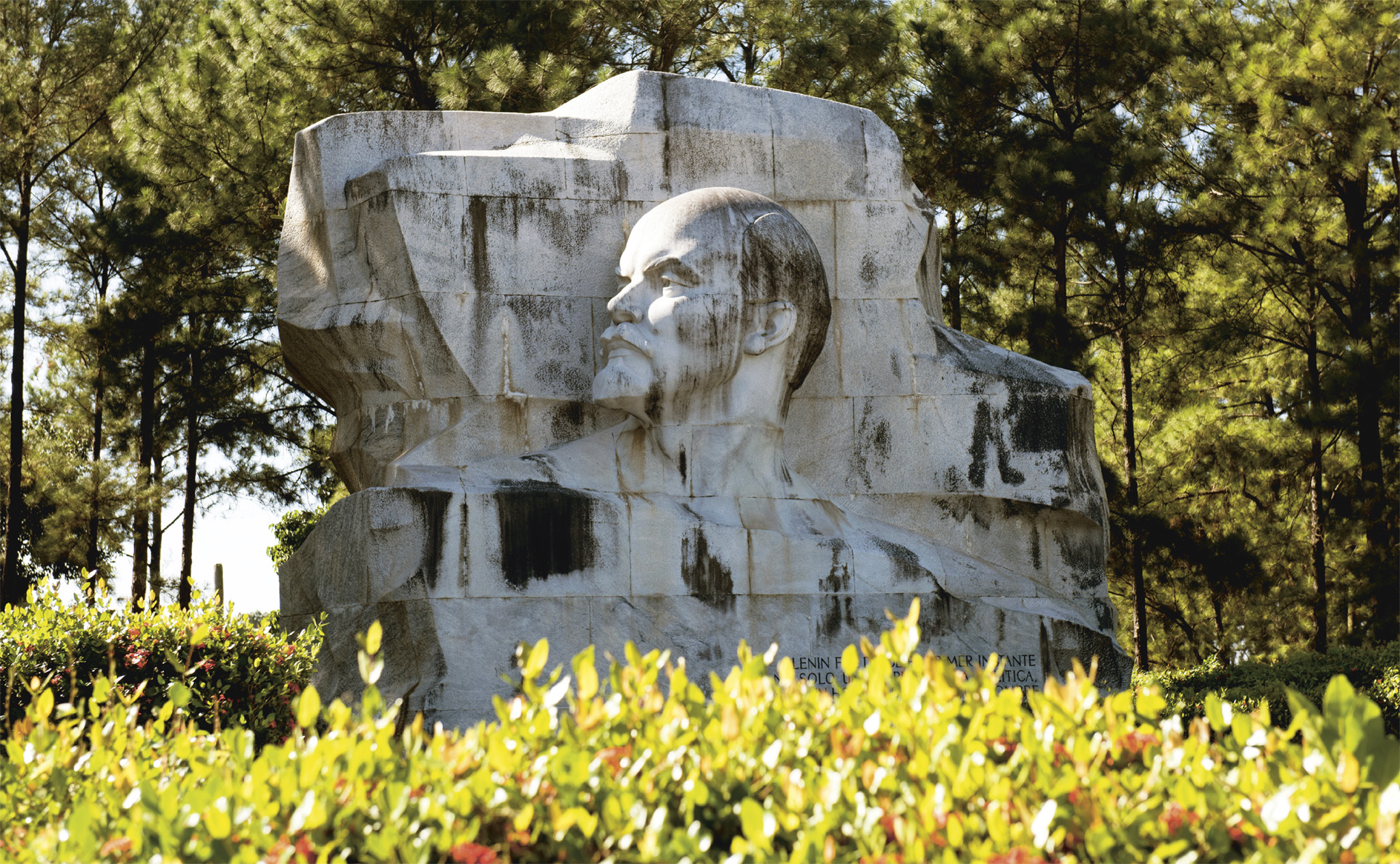
t Huge carved granite monument to Lenin in the park that bears his name
Located 20 km (12 miles) south of Central Havana and occupying 7.5 sq km (3 sq miles), Lenin Park was created in the 1970s, under the orders of Celia Sánchez, as an amusement park for children and a green area for an expanding city. Ever since it was created, Parque Lenin has been the largest recreation area in all of Havana.
Russian architect Lev Korbel designed the vast monument honouring the Soviet leader. Weighing 1,200 tons and 9 m (30 ft) high, it was completed in 1982 under the supervision of park designer Antonio Quintana Simonetti.
Habaneros love to walk here among the palm, cedar, pine and araucaria trees. On top of its natural beauty, the park is also home to many attractions including the original fairground rides, which have an old-fashioned air, a freshwater aquarium, stables, outdoor cinema, art gallery, swimming pools, café and Las Ruínas restaurant. The latter occupies a 1960s building that incorporates the crumbling walls of an old plantation house.
Nearby, among gardens and tree-lined paths, is the largest exhibition centre in Cuba, ExpoCuba, which hosts events all year. In autumn the famous Feria Internacional de La Habana offers an overview of Cuba’s economic and socio-political life.
ExpoCuba
§ 7697 4252

t People strolling past the Santuario Nacional de San Lázaro
This sanctuary, dedicated to St Lazarus, the patron saint of the sick, lies in the small village of El Rincón, outside Santiago de las Vegas. Appropriately, it is located next to an old lepers’ hospital, which now specializes in dermatology.
In Afro-Cuban religions Lazarus, from the Bible, corresponds to Babalú Ayé. Both Lazarus and Babalú Ayé are represented in folk iconography as old men dressed in tatters and covered with sores. In the case of the African saint, the skin disease was supposedly punishment from Olofi, the father of all the gods, for the saint’s adulterous and libertine past.
On the saint’s feast day, 17 December, the simple white sanctuary welcomes thousands of worshippers, many of whom have crawled from Havana. They flock here to make vows and requests to St Lazarus (called milagroso or “the miraculous one”), or to ask for his healing powers. The pilgrims light candles, leave fragrant flowers and make offerings at the sanctuary’s altars. The water from the fountain to the right of the sanctuary is considered by believers to miraculously cure diseases and ease pain.
Most people simply pass through Santiago de las Vegas without stopping while en route to, or from, José Martí International Airport or the Santuario Nacional de San Lázaro, in nearby Rincón. But this town, which is connected to Havana via the multi-lane Avenida de Boyeros, is also the gateway to the hilltop Mausoleo de General Antonio Maceo Grajales, at El Cacahual. The avenue winds uphill to this impressive site where the Wars of Independence hero – known as “Titan of Bronze” – is buried beneath a marble tomb with bas-reliefs of his image and that of other Mambises (independence fighters). The general was killed nearby at the Battle of San Pedro on 7 December 1896. A small museum recalls details of Maceo’s life.
The town itself is graced by the Parque Juan Delgado, which is overlooked by a handsome church, dating from 1694, and a statue of Colonel Juan Delgado González, who bravely retrieved Maceo’s corpse.
This huge 6-sq-km (2-sq-mile) botanical garden, set in an area of woods and cultivated fields, contains plants from all over the world. The gardens are divided into zones by geography, and the Caribbean section, which takes up one-fifth of the garden, has 7,000 flowering plants, half of them unique to Cuba. There are also curiosities such as the Archaic Woods, with descendants of ancient plants, and the Palmetum, with a large collection of palm trees.
The cactus area near the entrance is a must-see, but the most interesting part of the park is the Jardín Japonés, a Japanese garden with waterfalls and a pond with a gazebo. It was donated to Cuba by the local Asian community in 1989. Another fascinating sight is the orchid garden, with many varieties.
Experience Beyond the Centre
|
eat Corte del Principe This authentic Italian restaurant serves divine dishes, such as beef carpaccio and homemade pasta. ⌂ Calle 9na y 74, Playa § 5255 9091 \ Río Mar This paladar is set in a fabulous 1950s home, with a terrace overlooking the Río Almandares. Order a seafood dish here. ⌂ Avenida 3ra y Final, La Puntilla § 7720 4838 \ El Aljibe An open-air state-run restaurant serving delicious all-you-can-eat roast chicken with white rice, black beans and all the trimmings. ⌂ Avenida 7ma y 24, Playa § 7204 1583 \ |
